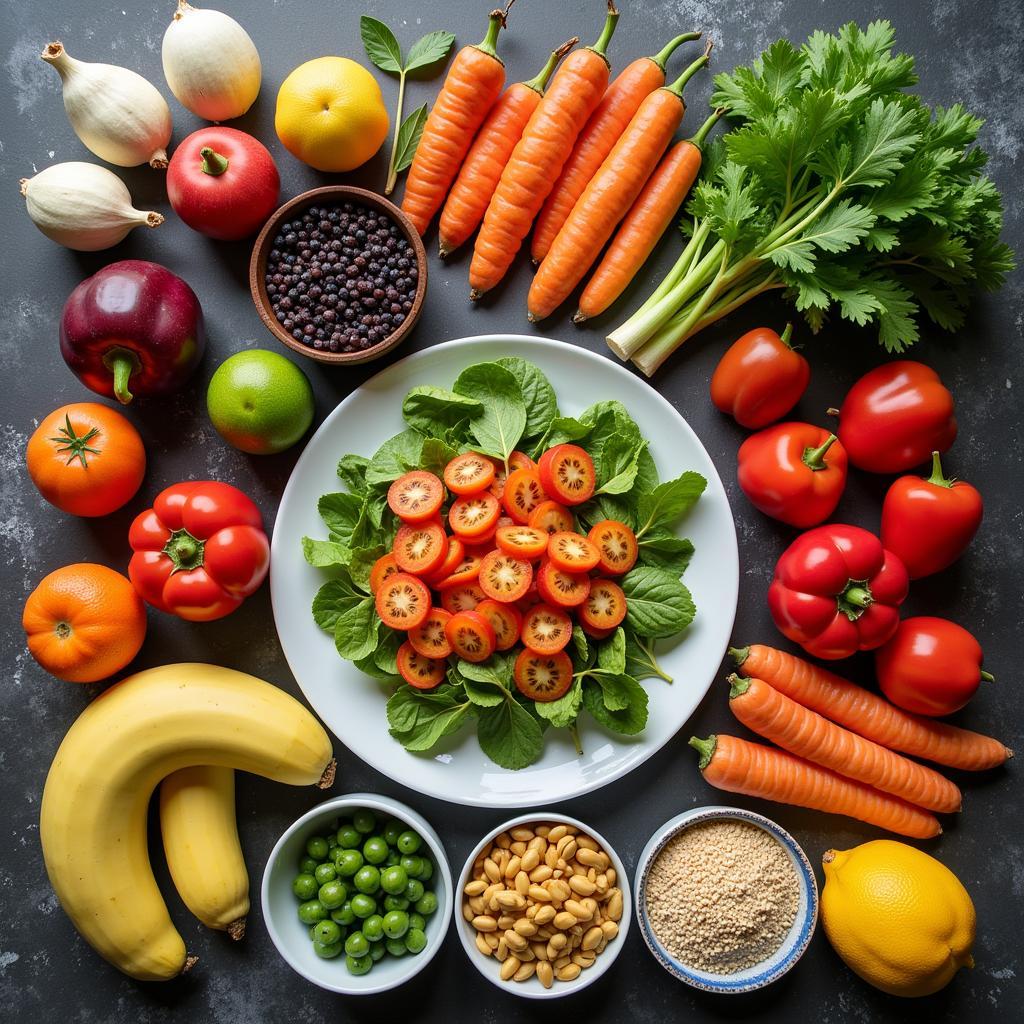The Ultimate Guide to African Grey Chop Recipe: Nourishing Your Feathered Friend
African Grey parrots, renowned for their intelligence and charisma, require a diet as rich and diverse as their wild counterparts. While commercially prepared pellets are convenient, a significant portion of their diet should consist of fresh foods like the “African Grey Chop”. This article delves into the intricacies of preparing this nutritious and flavorful meal that your avian companion will relish.
Understanding the African Grey Diet: Why “Chop” Matters
African grey chop goes beyond basic seed mixes. It’s a vibrant blend of fresh vegetables, fruits, grains, and legumes, mimicking the varied diet these parrots naturally seek in the wild. This dietary approach offers several benefits:
- Enhanced Nutrition: Chop provides a wider range of vitamins, minerals, and antioxidants than seeds alone.
- Mental Stimulation: The act of foraging and choosing from a variety of foods keeps your parrot mentally engaged.
- Hydration: Many fresh ingredients in a chop offer a natural source of hydration, crucial for birds.
Crafting the Perfect African Grey Chop Recipe
Creating a chop is akin to composing a culinary masterpiece. You’ll need a variety of fresh, high-quality ingredients, and a dash of love. Here’s a step-by-step guide:
1. Gather Your Ingredients
The beauty of chop lies in its versatility. Aim for a colorful mix from these categories:
- Vegetables: Leafy greens (kale, spinach, dandelion greens), carrots, broccoli, sweet potatoes, bell peppers, zucchini
- Fruits: Apples (remove seeds), berries, bananas, melons, oranges (in moderation)
- Grains: Cooked brown rice, quinoa, oats
- Legumes: Cooked lentils, beans (kidney, black, pinto)
- Other: Cooked pasta, chopped hard-boiled eggs (in moderation)
 Colorful and Fresh Ingredients for African Grey Parrot Chop
Colorful and Fresh Ingredients for African Grey Parrot Chop
2. Wash and Chop
Thoroughly wash all produce to remove pesticides and dirt. Chop ingredients into bite-sized pieces, considering your parrot’s size and beak strength. Smaller pieces are easier to eat, while larger pieces offer a bit of a challenge.
3. Cook (If Necessary)
Some ingredients, like grains and legumes, need to be cooked before adding to the chop. Cook them according to package instructions and ensure they are cooled completely before mixing.
4. Combine and Serve
Mix all ingredients thoroughly in a large bowl. You can serve the chop fresh or store it in the refrigerator for up to 3 days.
Essential Tips for a Successful African Grey Chop
- Variety is Key: Rotate ingredients regularly to keep your parrot interested and provide a wider range of nutrients.
- Introduce New Foods Gradually: Offer new foods alongside familiar ones to avoid digestive upset.
- Monitor Your Parrot: Observe your parrot’s preferences and adjust the recipe accordingly.
- Consult Your Avian Veterinarian: Discuss your parrot’s specific dietary needs and any concerns with a qualified professional.
African Grey Chop: A Labor of Love
Preparing an African grey chop is a rewarding experience. It’s a chance to provide your feathered friend with a delicious and nutritious meal that contributes to their overall health and well-being. With a little effort and creativity, you can create a chop that your parrot will love.
Remember, a healthy diet is just one aspect of responsible parrot ownership. Providing African grey bird food that encompasses fresh chop, along with mental stimulation, social interaction, and a safe environment, will ensure a long and happy life for your African Grey companion.
FAQs about African Grey Chop
1. How much chop should I feed my African Grey daily?
Offer approximately 1/4 to 1/2 cup of fresh chop daily, alongside a small portion of high-quality pellets. Adjust the amount based on your parrot’s individual needs and activity level.
2. Can I freeze African grey chop?
Yes, you can freeze chop in airtight containers for up to 3 months. Thaw it overnight in the refrigerator before serving.
3. My parrot is picky, what can I do?
Introducing new foods can be tricky. Try offering new ingredients in small amounts alongside your parrot’s favorite foods. Persistence is key!
4. What are some healthy treats to offer in addition to chop?
Nuts like almonds and walnuts (in moderation), small pieces of cooked chicken or fish, and millet sprays make great treats.
5. Are there any foods I should avoid feeding my African Grey?
Yes, avoid avocado, chocolate, caffeine, alcohol, salty snacks, and sugary treats, as these can be toxic to parrots.
For more insightful information on caring for your African Grey, explore our comprehensive guide to African grey food recipes. We also have a collection of delectable African grey parrot food recipes that will tantalize your feathery friend’s taste buds.
Looking for culinary inspiration beyond bird food? Discover the vibrant world of African cucumber recipes and add a touch of African flavor to your own dining experience.
Need further assistance in caring for your African Grey? Contact us at +255768904061, email us at kaka.mag@gmail.com, or visit us at Mbarali DC Mawindi, Kangaga, Tanzania. Our dedicated customer support team is available 24/7 to assist you.
